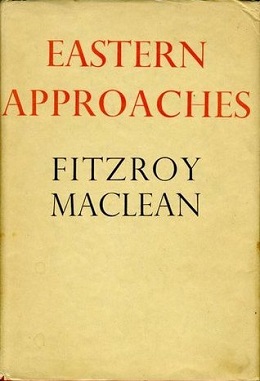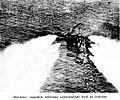
The Desert Air Force (DAF), also known chronologically as Air Headquarters Western Desert, Air Headquarters Libya, the Western Desert Air Force, and the First Tactical Air Force (1TAF), was an Allied tactical air force created from No. 204 Group RAF under RAF Middle East Command in North Africa in 1941 to provide close air support to the British Eighth Army against Axis forces. Throughout the Second World War, the DAF was made up of squadrons from the Royal Air Force (RAF), the South African Air Force (SAAF), the Royal Australian Air Force (RAAF), the United States Army Air Forces (USAAF) and other Allied air forces.

Eastern Approaches (1949) is a memoir of the early career of Fitzroy Maclean. It is divided into three parts: his life as a junior diplomat in Moscow and his travels in the Soviet Union, especially the forbidden zones of Central Asia; his exploits in the British Army and SAS in the North Africa theatre of war; and his time with Josip Broz Tito and the Partisans in Yugoslavia.

No. 38 Squadron of the Royal Air Force was a bomber squadron formed in 1916 and was disbanded most recently in 1967.

World War II in the Kingdom of Yugoslavia began on 6 April 1941, when the country was invaded and swiftly conquered by Axis forces and partitioned among Germany, Italy, Hungary, Bulgaria and their client regimes. Shortly after Germany attacked the USSR on 22 June 1941, the communist-led republican Yugoslav Partisans, on orders from Moscow, launched a guerrilla liberation war fighting against the Axis forces and their locally established puppet regimes, including the Axis-allied Independent State of Croatia (NDH) and the Government of National Salvation in the German-occupied territory of Serbia. This was dubbed the National Liberation War and Socialist Revolution in post-war Yugoslav communist historiography. Simultaneously, a multi-side civil war was waged between the Yugoslav communist Partisans, the Serbian royalist Chetniks, the Axis-allied Croatian Ustaše and Home Guard, Serbian Volunteer Corps and State Guard, Slovene Home Guard, as well as Nazi-allied Russian Protective Corps troops.
Operation Typical was the name of the first World War II British mission fully assigned to Yugoslav Partisans HQ and Marshall Tito organised by the Special Operations Executive (SOE). The six soldiers flew from Derna airfield on 27 May 1943 and parachuted to Black Lake in Montenegro at the height of a large German offensive Operation Schwarz which aimed to destroy the Partisan forces. The group was led by Col William Deakin and Capt William F Stuart, together with the two radio operators - Sergeants Walter Wroughton and Peretz 'Rose' Rosenberg. Canadian-Yugoslav Ivan ('John') Starčević acted as a translator and Sgt John Campbell (RM) was a cipher clerk, and bodyguard.

The Air Force of the Independent State of Croatia, was the air force of the Independent State of Croatia (NDH), a puppet state established with the support of the Axis Powers on the territory of the Kingdom of Yugoslavia during World War II. The ZNDH was founded under German authority in April 1941, following the German-led Axis invasion of Yugoslavia.

The Belgrade offensive or the Belgrade strategic offensive operation was a military operation during World War II in Yugoslavia in which Belgrade was liberated from the German Wehrmacht through the joint efforts of the Soviet Red Army, Yugoslav Partisans, and the Bulgarian Army. Soviet forces and local militias launched separate but loosely cooperative operations that undermined German control of Belgrade and ultimately forced a retreat. Martial planning was coordinated evenly among command leaders, and the operation was largely enabled through tactical cooperation between Josip Broz Tito and Joseph Stalin that began in September 1944. These martial provisions allowed Bulgarian forces to engage in operations throughout Yugoslav territory, which furthered tactical success while increasing diplomatic friction.
In 1941 when the Axis invaded Yugoslavia, King Peter II formed a Government in exile in London, and in January 1942 the royalist Draža Mihailović became the Minister of War with British backing. But by June or July 1943, British Prime Minister Winston Churchill had decided to withdraw support from Mihailović and the Chetniks he led, and support the Partisans headed by Josip Broz Tito, even though this would result in "complete communist control of Serbia". The main reason for the change was not the reports by Fitzroy Maclean or William Deakin, or as later alleged the influence of James Klugmann in Special Operations Executive (SOE) headquarters in Cairo or even Randolph Churchill, but the evidence of Ultra decrypts from the Government Code and Cipher School in Bletchley Park that Tito's Partisans were a "much more effective and reliable ally in the war against Germany". Nor was it due to claims that the Chetniks were collaborating with the enemy, though there was some evidence from decrypts of collaboration with Italian and sometimes German forces.

The 859th Special Operations Squadron is a reserve unit of the United States Air Force. It was first activated in October 1942 as the 517th Bombardment Squadron, when the Army Air Forces replaced National Guard observation units that had been mobilized and were performing antisubmarine patrols off the Atlantic coastline. A month after its activation, the squadron was redesignated the 12th Antisubmarine Squadron. In August 1943, the Army Air forces began turning the antisubmarine patrol mission over to the Navy and the squadron moved to California, where, as the 859th Bombardment Squadron, it formed the cadre for the 492d Bombardment Group.

No. 351 Squadron RAF was a Yugoslav Partisan-manned fighter-bomber squadron of the Royal Air Force (RAF) which was operational between 13 October 1944 and 1 May 1945 during World War II. The squadron was also known by the Partisans as Second Squadron (NOVJ).

No. 352 Squadron RAF was a Yugoslav-manned fighter-bomber squadron of the Royal Air Force during the Second World War. The squadron was also known as First NOVJ Squadron.

The Adriatic campaign of World War II was a minor naval campaign fought during World War II between the Greek, Yugoslavian and Italian navies, the Kriegsmarine, and the Mediterranean squadrons of the United Kingdom, France, and the Yugoslav Partisan naval forces. Considered a somewhat insignificant part of the naval warfare in World War II, it nonetheless saw interesting developments, given the specificity of the Dalmatian coastline.

The 51st Troop Carrier Wing is an inactive United States Air Force unit. The wing was formed during World War II and was the first troop carrier wing in the Army Air Forces (AAF) organized for deployment overseas. During the war, it served in the Mediterranean Theater of Operations, and its elements participated in every airborne assault in the theater. The wing also transported personnel and supplies within the theater. Its units also performed the majority of special operations flights by AAF units in the theater. Following V-E Day, the wing moved to Germany, where it became part of the occupation forces, operating as the European Air Transport Service until inactivating in January 1948. In August 1946, two of its planes were shot down by Yugoslav Air Force fighters near Yugoslavia's border with Austria and Italy.
Air warfare during World War II in Yugoslavia pitted the Yugoslav Air Force, both Royal and NOVJ, United States Army Air Force (USAAF), the Royal Air Force (RAF), including the Balkan Air Force, and Soviet Air Forces against the German Luftwaffe, the Italian Regia Aeronautica and the Air Force of the Independent State of Croatia. The latter provided the majority of the support for the ground operations against the Partisans. The Allied forces engaged in an extensive bombing campaign in an effort to weaken the Axis hold on the country.

The 783d Bombardment Squadron was activated in 1943. After organizing and training with Consolidated B-24 Liberators in the United States. it served in combat in the Mediterranean Theater of Operations as a heavy bomber unit in the strategic bombing campaign against Germany. The squadron earned two Distinguished Unit Citations for its actions. After V-E Day, the squadron served in Air Transport Command, ferrying men from the combat theater back to the United States until inactivating in July 1945.
Operation Ratweek was a series of coordinated attacks on the Axis forces' communication lines in the Balkans during World War II. Launched on 1 September 1944. the attack was led by the combined operations units of the Yugoslav Partisans, Land Forces Adriatic, the heavy bombers of the U.S. 15th Air Force and the light and medium bombers of the Balkan Air Force.

In late 1937, the Royal Yugoslav Air Force placed an order with Hawker Aircraft for twelve Hawker Hurricane Mk I fighters, the first foreign purchase of the aircraft. The VVKJ operated the British Hawker Hurricane Mk I from 1938 to 1941. Between 1938 and 1940, the VVKJ obtained 24 Hurricane Mk Is from early production batches, marking the first foreign sale of the aircraft. Twenty additional aircraft were built by Zmaj under licence in Yugoslavia. When the country was drawn into World War II by the German-led Axis invasion of April 1941, a total of 41 Hurricane Mk I's were in service as fighters. They achieved some successes against Luftwaffe aircraft, but all Yugoslav Hurricanes were destroyed or captured during the 11-day invasion.
The Maclean Mission (MACMIS) was a World War II British mission to Yugoslav partisans HQ and Marshal Tito organised by the Special Operations Executive (SOE) in September 1943. Its aim was to assess the value of the partisans contribution to the Allied cause and the means to increase it. It was led by a recently promoted Brigadier Fitzroy Maclean and was first such mission with full authorization and a personal message from Winston Churchill. His memoir of these years forms the final third of Eastern Approaches (1949).

Arkadije Popov was a Yugoslav pilot of Russian descent.

The Battle of Serbia was a joint Allied effort with the aim of establishing a strong foothold and mastering the central communication area of the German forces on the Balkans, i.e. Army Group F, during World War II. Actions on the ground were carried out by the NOVJ, and the Allies provided combat assistance, supplies and air support.
























